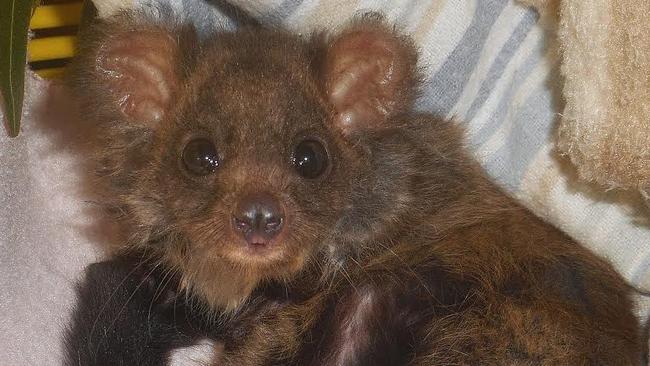Baby greater glider growing stronger after her mother was killed by barbed wire
THEY’RE rarely seen in the wild but this little Cherub is being nursed back to health after she was found on the back of her dead mother.

QLD News
Don't miss out on the headlines from QLD News. Followed categories will be added to My News.
A RARELY seen baby greater glider is being brought back to health after it was found on the back of its dead mother in Far North Queensland.
Named ‘Cherub’ by wildlife carer, Pam Tully of BatReach Rescue and Rehabilitation Centre in Kuranda, the furry glider only weighed 90g when it was first brought to her on October 8 from outside Mount Garnet.
“Her mother was caught up on a barbed wire fence on a cattle property along Gunawarra Rd, outside Mount Garnet,” Ms Tully said.
WILDLIFE: Killer barbs responsible for deaths
“She got to me after four days or so and was very dehydrated, so it was touch and go for a week.”
Ms Tully syringe-fed Cherub – who is believed to be about three months old – with possum milk replacer around the clock on her arrival. She is now down to four syringe feeds a day, supplemented with eucalyptus leaves and has reached a healthier 130g.
Ms Tully said Cherub won’t be released until she reaches at least 900g and was able to solely eat eucalyptus leaves, the greater glider’s food of choice.
In the meantime, Cherub is spending her time snuggled in a fabric pouch in a basket inside Ms Tully’s house.
Although Ms Tully was used to nursing animals like bats, flying foxes, squirrel gliders, sugar gliders, possums and striped possums back to health, Cherub was only the third greater glider that had come into her care.
“I’ve had two before at separate times, about a year ago. One was a lot smaller and unfortunately too dehydrated,” she said. “Her mum was also a barbed wire victim.
“The other one was found on the ground, so I’m not sure if she had internal injuries. Neither made it.”

Ms Tully said barbed wire fences were a big problem for greater gliders.
“They glide and land on it, not realising its barbed,” she said.
“It also happens with flying foxes, birds, owls and squirrel gliders, especially at this time of year.
“We’ve had a lot of wind, they fly low and fly into the fence, not realising it’s going to be trapped and that’s the end of them.”
Greater gliders are rarely spotted due to being nocturnal and preferring to eat the eucalyptus leaves at the top of trees. They live alone, except during breeding season, and sleep in hollowed out dens in trees during the day.
Ms Tully, who used to be a nocturnal tour guide, said she would sometimes spot one in the rainforest as she climbed higher up the mountains of the Lamb Range.
Andrew Krockenberger, Dean of Research at James Cook University in Cairns, said greater gliders are found all the way down the east coast to Victoria, but a smaller subspecies existed from Far North Queensland to Central Queensland.
“They are little compared with their southern counterparts, which are about 1.5kg,” he said.
“The ones in the north are half that size.”
Professor Krockenberger said there was not a lot known about the population of greater gliders in Australia due to their difficulty to spot.
“Not many people go out there with a spotlight at night,” he said.
“They’re not uncommon, but they’re not often seen by your average person.”
“What we do know is that 10 per cent of the forest has 70 per cent of the animals with the eucalypt feeders in them.”
He said habitat destruction and barbed wire fences were among their biggest survival threats.
“Greater gliders don’t disperse very well or go into new places, and they don’t come down very much.”
Heather Janetzki, collections manager at the Queensland Museum, said greater gliders preferred to feed on two specific species of eucalyptus leaf.
“Often, they’re right up the top with the newer leaves and you can see them peering down at you with really long tails if you’re out spotlighting,” she said.
She said they can glide to trees about 100m away, but start at the top then glide low, before climbing to the top and starting again, which is often why they end up crashing into barbed wire fences.
“They’ll land on top of a barbed wire fence in particular, and go around and around and it’s miserable for them,” Ms Janetzki said.
“We encourage farmers to change the top of the fence to a plain line, or to put conduit over areas where (all types of) gliders are known to be coming and going in that area.”




